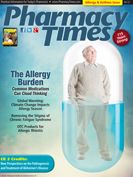Publication
Article
Pharmacy Times
Allergy & Asthma Watch
Allergy Season Slated to Be Worse than Ever
The unusually wet, mild winter, the lack of a true frost, and the premature budding of trees this spring will have a compounding effect on hay fever and allergy sufferers, according to a recent article in The Washington Post.
Patients can endure a certain amount of exposure to allergens in the beginning of the season, but once they pass an “allergy threshold,” their bodies will start to react to the allergens. This is known as priming, according to allergist Jackie Eghrari-Sabet, MD, and because people with allergies were exposed to fall pollens, ragweed, and winter mold for longer periods this season, their reactions to weed pollens and other molds later in the summer may be worse.
“Now we come into spring and people are already inflamed and congested and absolutely primed for a more significant reaction to the tree pollen, because we haven’t really had a dormant season in all of this,” Dr. Eghrari-Sabet told the Post.
The article points out that patients are also suffering from allergy symptoms more intensely because they have spent more time outside as a result of the warm weather, thereby increasing their exposure.
To avoid contact with allergens, Derek Johnson, MD, director of the Fairfax Allergy, Asthma & Sinus Clinic, suggests using air-conditioning on the recirculate cycle and changing clothes and showering after outdoor activities. He advises against exercising early in the morning, when pollen counts are highest. Use of preventive measures such as antihistamines and nasal sprays as early in the season as possible is also recommended.
Asthma Increases the Risk of Shingles in Children
New research from the Mayo Clinic presented at the American Academy of Allergy, Asthma & Immunology annual meeting suggests that children younger than 18 years who are diagnosed with asthma face a greater risk of developing shingles from the herpes zoster virus.
Shingles is characterized by painful raised lesions and is caused by the same virus responsible for chicken pox, the varicella-zoster virus. It usually affects people older than 60 years of and those with weakened immune systems. Approximately 1 of 3 people in America will develop shingles in their lifetimes, according to the Centers for Disease Control and Prevention.
In a large epidemiologic survey using data from the Rochester Epidemiology Project from 1996 to 2001, lead author Young Juhn, MD, and colleagues found that children who were diagnosed with asthma were 2.2 times more likely to develop shingles.
“We were surprised by the study findings because most of our previous work showing increased risk of microbial infections in asthmatics was based on airway-related microbial infections such as serious pneumococcal disease, strep infections or pertussis,” Dr. Juhn noted. “However, shingles is not an airway-related illness, and cell-mediated immune function is an important host-defense mechanism from developing shingles.”
Based on the findings, the researchers plan to extend their study to adults with asthma so they can further investigate the connection between asthma and shingles.
Allergens Can Trigger Asthma Attacks
Although many people know the signs and symptoms of asthma, such as wheezing, shortness of breath, chest tightness, and coughing, few know that asthma is often an allergic response triggered by the exposure to an allergen.
According to the National Institutes of Health, 60% of individuals in the United States with asthma have allergic asthma. Allergic asthma’s exacerbations are triggered by the production of the antibody immunoglobulin E in response to the presence of an allergen.
In a study presented at the American Academy of Allergy, Asthma & Immunology annual meeting, Talal M. Nsouli, MD, of Georgetown University School of Medicine, analyzed 122 patients with asthma diagnosed according to American Thoracic Society criteria. Participants were tested for allergies to trees, grasses, dust, mold, cats, and dogs through spirometry and skin testing.
The results showed that 93 patients, or 76%, had allergy skin tests that were positive for environmental allergens that “correlated clinically” with a history of asthma symptoms.
Although many patients assumed the exacerbation of their asthma had nothing to do with allergies, Dr. Nsouli noted, it can take up to 3 years for a patient to appear allergic to an offending agent.
“We want primary care providers, family doctors, internists and patients, as well as asthmatic patients, to be aware of this connection between allergy and asthma and to know that allergen exposure in allergic individuals is a major inducer of airway inflammation and obstruction,” he said. “Asthma management should include an allergy evaluation for potential allergen avoidance to further help decrease morbidity and mortality from bronchial asthma.” PT

Newsletter
Stay informed on drug updates, treatment guidelines, and pharmacy practice trends—subscribe to Pharmacy Times for weekly clinical insights.






